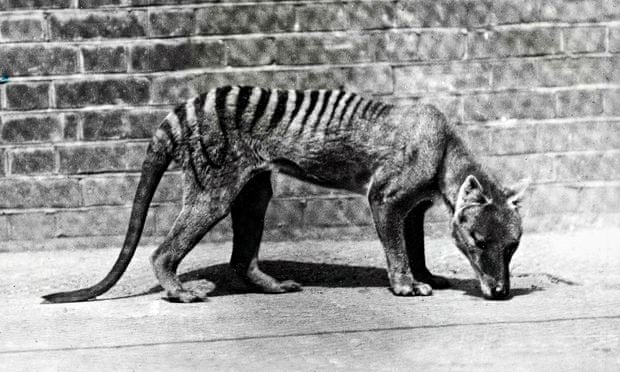Many species are already critically endangered and close to
extinction, including the Sumatran elephant, Amur leopard and mountain
gorilla. But also in danger of vanishing from the wild, it now appears,
are animals that are currently rated as merely being endangered:
bonobos, bluefin tuna and loggerhead turtles, for example. In each case, the finger of blame points directly at human
activities. The continuing spread of agriculture is destroying millions
of hectares of wild habitats every year, leaving animals without homes,
while the introduction of invasive species, often helped by humans, is
also devastating native populations. At the same time, pollution and
overfishing are destroying marine ecosystems.
“Habitat destruction, pollution or overfishing either kills off wild
creatures and plants or leaves them badly weakened,” said Derek
Tittensor, a marine ecologist at the World
Conservation
Monitoring Centre in Cambridge. “The trouble is that in coming decades,
the additional threat of worsening climate change will become more and
more pronounced and could then kill off these survivors.”
The problem, according to Nature, is exacerbated because of
the huge gaps in scientists’ knowledge about the planet’s biodiversity.
Estimates of the total number of species of animals, plants and fungi
alive vary from 2 million to 50 million. In addition, estimates of
current rates of species disappearances vary from 500 to 36,000 a year.
“That is the real problem we face,” added Tittensor. “The scale of
uncertainty is huge.”
In
the end, however, the data indicate that the world is heading
inexorably towards a mass extinction – which is defined as one involving
a loss of 75% of species or more. This could arrive in less than a
hundred years or could take a thousand, depending on extinction rates.
The Earth has gone through only five previous great extinctions, all
caused by geological or astronomical events. (The Cretaceous-Jurassic
extinction that wiped out the dinosaurs 65 million years ago was
triggered by an asteroid striking Earth, for example.) The coming great
extinction will be the work of Homo sapiens, however.
“In the case of land extinctions, it is the spread of agriculture
that has been main driver,” added Tittensor. “By contrast it has been
the over-exploitation of resources – overfishing – that has affected
sealife.” On top of these impacts, rising global temperatures threaten
to destroy habitats and kill off more creatures.
This change in climate has been triggered by increasing emissions –
from factories and power plants – of carbon dioxide, a gas that is also
being dissolved in the oceans. As a result, seas are becoming more and
more acidic and hostile to sensitive habitats. A third of all coral
reefs, which support more lifeforms than any other ecosystem on Earth,
have already been lost in the last few decades and many marine experts
believe all coral reefs could end up being wiped out before the end of
the century.
Similarly, a quarter of all mammals, a fifth of all reptiles and a
seventh of all birds are headed toward oblivion. And these losses are
occurring all over the planet, from the South Pacific to the Arctic and
from the deserts of Africa to mountaintops and valleys of the Himalayas.
A blizzard of extinctions is now sweeping Earth and has become a fact
of modern life. Yet the idea that entire species can be wiped out is
relatively new. When fossils of strange creatures – such as the mastodon
– were first dug up, they were assumed to belong to creatures that
still lived in other lands. Extant versions lived elsewhere, it was
argued. “Such is the economy of nature,” claimed Thomas Jefferson,
who backed expeditions to find mastodons in the unexplored interior of America.
Then the French anatomist Georges Cuvier showed that the
elephant-like remains of the mastodon were actually those of an “espèce
perdue” or lost species. “On the basis of a few scattered bones, Cuvier
conceived of a whole new way of looking at life,” notes Elizabeth
Kolbert in her book,
The Sixth Extinction: An Unnatural History. “Species died out. This was not an isolated but a widespread phenomenon.”
Since then the problem has worsened with every decade, as the Nature
analysis makes clear. Humans began by wiping out mastodons and mammoths
in prehistoric times. Then they moved on to the eradication of great
auks, passenger pigeons – once the most abundant bird in North America –
and the dodo in historical time. And finally, in recent times, we have
been responsible for the disappearance of the golden toad, the thylacine
– or Tasmanian tiger – and the Baiji river dolphin. Thousands more
species are now under threat.
In an editorial, Nature argues that it is now imperative
that governments and groups such as the International Union for
Conservation of Nature begin an urgent and accurate census of numbers of
species on the planet and their rates of extinction. It is not the most
exciting science, the journal admits, but it is vitally important if we
want to start protecting life on Earth from the worst impacts of our
actions. The loss for the planet is incalculable – as it is for our own
species which could soon find itself living in a world denuded of all
variety in nature. As ecologist Paul Ehrlich has put it: “In pushing
other species to extinction, humanity is busy sawing off the limb on
which it perches.”
